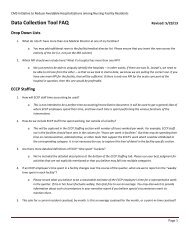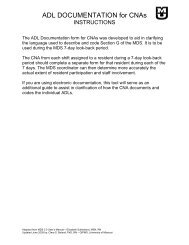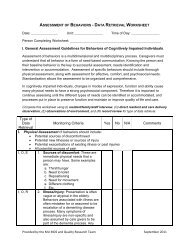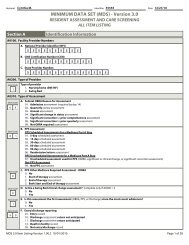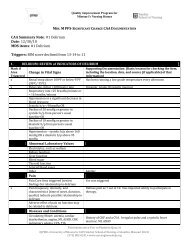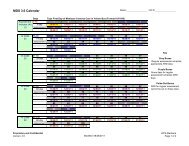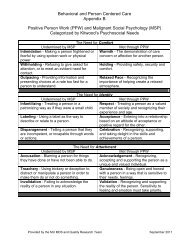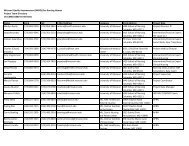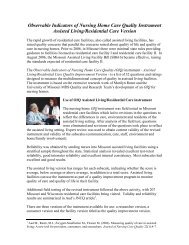National Guideline Clearinghouse (NGC). Guideline synthesis
National Guideline Clearinghouse (NGC). Guideline synthesis
National Guideline Clearinghouse (NGC). Guideline synthesis
You also want an ePaper? Increase the reach of your titles
YUMPU automatically turns print PDFs into web optimized ePapers that Google loves.
RNAO<br />
(2005)<br />
A head-to-toe skin assessment should be carried out with all clients at<br />
admission, and daily thereafter for those identified at risk for skin<br />
breakdown. Particular attention should be paid to vulnerable areas,<br />
especially over bony prominences.<br />
(Level of Evidence = IV)<br />
Avoid massage over bony prominences.<br />
(Level of Evidence = IIb)<br />
Protect and promote skin integrity:<br />
Ensure hydration through adequate fluid intake.<br />
Individualize the bathing schedule.<br />
Avoid hot water and use a pH balanced, non-sensitizing skin<br />
cleanser.<br />
Minimize force and friction on the skin during cleansing.<br />
Maintain skin hydration by applying non-sensitizing, pH balanced,<br />
lubricating moisturizers and creams with minimal alcohol content.<br />
Use protective barriers (e.g., liquid barrier films, transparent films,<br />
hydrocolloids) or protective padding to reduce friction injuries.<br />
(Level of Evidence = IV)<br />
Protect skin from excessive moisture and incontinence:<br />
Assess and manage excessive moisture related to body fluids (e.g.,<br />
urine, feces, perspiration, wound exudates, saliva)<br />
Gently cleanse skin at time of soiling. Avoid friction during care<br />
with the use of a spray perineal cleaner or soft wipe.<br />
Minimize skin exposure to excess moisture. When moisture cannot<br />
be controlled, use absorbent pads, dressings, or briefs that wick<br />
moisture away from the skin. Replace pads and linens when damp.<br />
Use topical agents that provide protective barriers to moisture.<br />
If unresolved skin irritation exists in a moist area, consult with the<br />
physician for evaluation and topical treatment.<br />
Establish a bowel and bladder program.<br />
(Level of Evidence = IV)<br />
Positioning and Pressure-Relieving Devices<br />
HIGN<br />
(2008)<br />
Agency for Health Care Policy and Research (now known as the Agency<br />
for Healthcare Research and Quality, AHRQ) (AHCPR, 1992) prevention<br />
recommendations:<br />
Turn and position bed-bound clients every 2 hours if consistent<br />
with overall care goals.<br />
Use a written schedule for turning and repositioning clients.<br />
6 of 17



